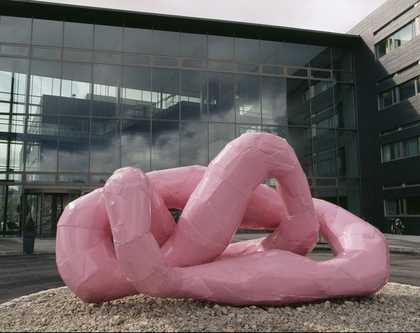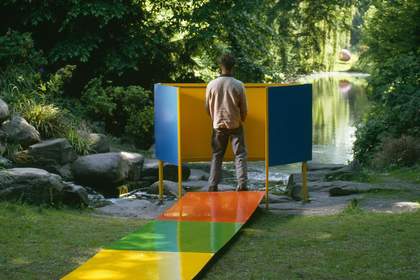
Franz West Étude de couleur 1991/1997 (Skulptur Projekte, Münster, 1997)
Franz West has often been described as an art world anarchist. His work places the viewer in new and unexpected situations which go against all preconceptions of what art viewing should be.
Each artwork is a playful comment on the world and people around him, an excuse for collaboration and a way of breaking free from institutional thought. It’s with this attitude that Franz West created a body of work which continues to provoke discussion and more importantly, laughter.
Franz West is open at Tate Modern until 2 June 2019
1. The man himself
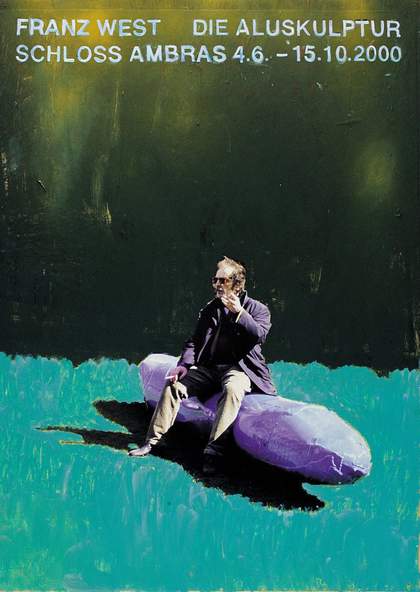
Franz West Plakatentwurf (Die Aluskulptur) 2000
Collage, gouache and offset printing on chipboard
Franz West Privatstiftung/ Estate Franz West, Vienna
Looking at his work, it’s not all that surprising that Franz West was a real character. Exhibition catalogue, Franz West gives us a taste of this thanks to its collection of essays from people who knew him. Here is an especially good extract from close friend and collaborator Rudolf Polanszky:
I remember one time he persuaded me to join him in Rome, where he was seeing an aristocratic lady … We arrived at the train station and tried to go to see her, but she was out, so we went to the Vatican instead. Franz in the Vatican Museum was interesting to see. He was totally fascinated by paintings of demons, by depictions of crazy people with their twitches. He’d stand in front of the paintings and mimic their movements. How people stared! Then we left and went to see his girlfriend, but, when we got to her place, her husband was there and threatened to shoot him. Franz was starving though, and there was a basket of raw eggs and I remember he guzzled about forty of them – just drank them down!
2. Wordplay

Franz West Hängebusen Ingrid late 1970s
Polyester, varnish, cardboard and clothes hanger
45 ×41 ×11
Private collection. Ingrid Karl – Franz Koglmann
West often moves between languages and meaning through the titles of his work, treading the line between academic and ridiculous. His influences range from the philosophical to the downright crude, and he somehow manages to bring all these conflicting references into one place.
One example is Hängebusen Ingrid from the late 1970s. West integrated his friends into his work at every opportunity, and Ingrid is actually the name of a close friend to whom he gifted the work. Hängen means ‘to hang’ in German and the piece is designed to be hung on the wall. It all sounds sweet until you realise that Hängebusen also means ‘saggy breasts’. Ingrid must have been flattered.
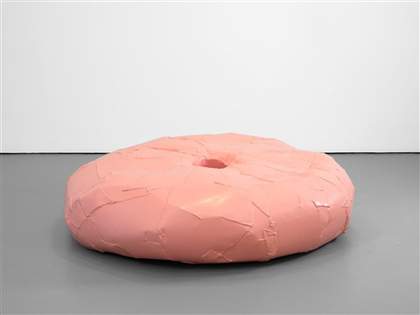
Franz West Cool Book 2007 Tate © Franz West
Another play on words is West’s series of seating sculptures, entitled Cool Book. Looking at the piece you really have to wonder what it has to do with books. The answer is, nothing. The words refer to the Italian phrase ‘buco del culo’ which means ‘asshole’. So when you sit on this bright pink doughnut form, he’s actually placed you on a giant anus for all to see.
3. Socially awkward furniture
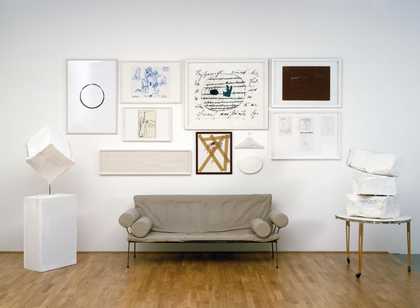
Franz West
Viennoiserie (1998)
Tate
West’s approach to art-making extended far beyond sculpture. He often explored interior and furniture design within his work, using functional objects as a basis for conceptual ideas.
Unlike most furniture design, which is meant to be functional, most of West’s designs are deliberately awkward. This was his way of subverting our expectations of how to behave in public. He clearly enjoyed making his audience uncomfortable and delighted in observing the ways in which they navigated these bizarre situations.
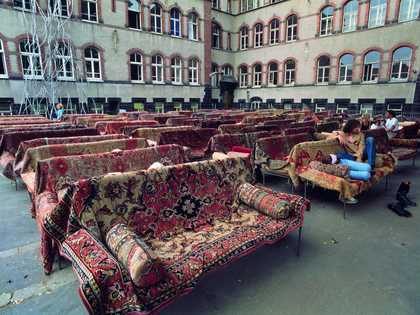
Franz West Auditorium 1992
(documenta IX, Kassel, 1992) 72 divans with cushions, iron and construction steel covered in carpet
Centre national des arts plastiques
On loan to Centre Pompidou, Musée national d’art moderne, Paris
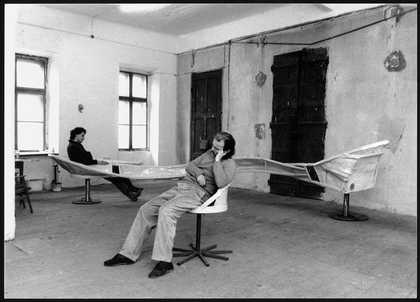
Franz West Eo Ipso 1987 (in the artist’s studio). Iron and paint, 2 parts: 118×546×115, 83×57×52. MAK – Österreichisches Museum für angewandte Kunst /Gegenwartskunst, Vienna
One piece in particular is Eo Ipso. The two seats of the elongated love-seat are so far away you can’t have a comfortable conversation with the other person. The seats also have low backs so you are exposed to onlookers. There is nothing practical about this set up and you inevitably end up looking stupid.
Meanwhile Auditorium was created after West visited all the dry cleaners in Vienna asking for abandoned and worn out Persian rugs. The tatty carpets were then draped over a metal frame covered with foam to form a makeshift sofa. In total he built seventy-two of these sofas and displayed them for the first time at documenta IX... in the parking lot. As a result hundreds of visitors ended up lounging on manky rugs outside the main event. Just another example of West’s anti-establishment approach to art making.
4. Embarrassing sculptures
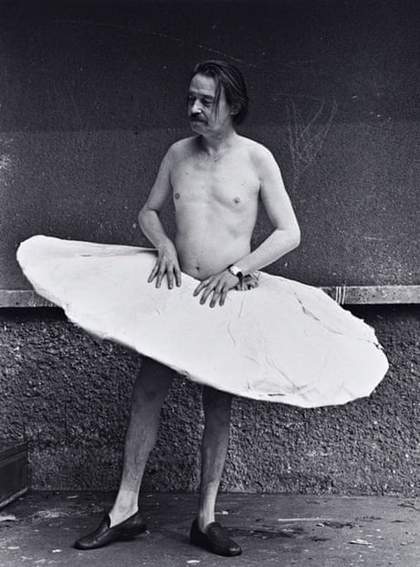
Franz West Otto Kobalek with Adaptive by Franz West 1974.
Photograph: Friedl Kubelka/The Hepworth Wakefield
He began making his Paßstücke sculptures (usually translated as 'Fitting Pieces', 'Adaptables' or 'Adaptives') in 1974. As with many of his sculptures, the artworks start from a miscellaneous object which he then coats in plaster until they become unrecognisable. The forms created are awkward, bulbous shapes, often featuring a thinner section which can function as a sort of handle. They are objects for which there is no obvious purpose or use. West encourages the viewer to interact with them, pick them up and find an appropriate way to hold them. This is turn leads to a strange stance, pose or dance which, in some iterations of the work, can be observed by other visitors. The perfect way to embarrass yourself in front of total strangers.
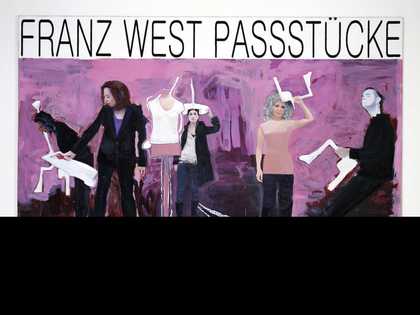
Franz West Plakatentwurf (Gagosian Gallery) 2007–8
Collage and acrylic paint on linen canvas
Franz West Privatstiftung/ Estate Franz West, Vienna
5. A global toilet tour
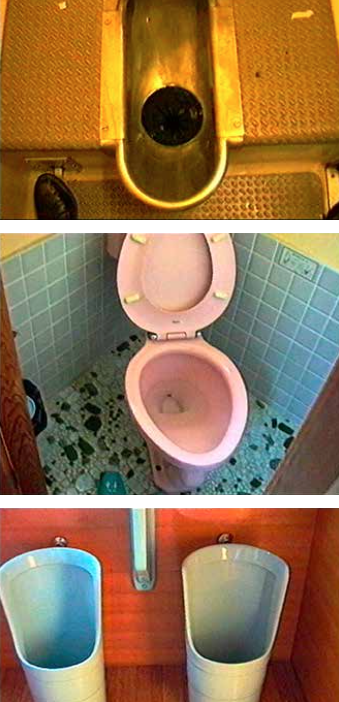
Franz West and Bernhard Riff Mood 1995 Video, colour, sound Tate © Franz West
West and Bernhard Riff worked together on a number of films. Much of their footage was accumulated during the many trips they made together and here Bernard describes one of their funniest works:
An unavoidable socio-cultural experience of travelling is the restroom. After studying and filming different kinds of lavatories all over the world, from France to Japan, New York to Vienna, we put together the six-minute video Mood 1995 (p.147) from our footage.3 West had the idea for an appropriate soundtrack using the accelerating and decelerating sounds of the Vienna subway as it stops and leaves the platform, the opening and closing of pneumatically controlled doors, and the voice of the conductor announcing ‘Zug fährt ab!’ (‘The train is leaving!’). The soundtrack adds a fluent, gliding movement and rhythm to the images of flushing water in toilet bowls and urinals.
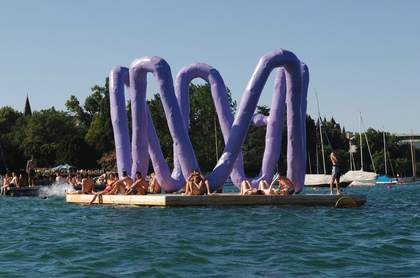
Franz West Corona 2006
Photo: Stefan Altenburger Photography, Zürich, courtesy Eva Presenhuber
Franz West is open at Tate Modern until 2 June 2019

